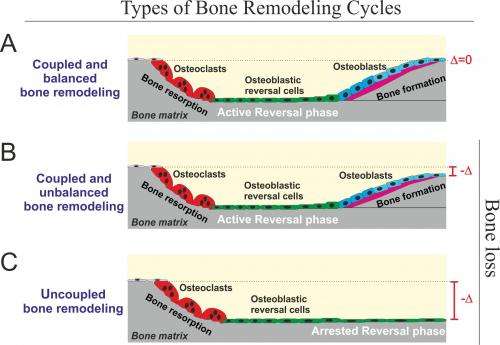Reversal cells may tip the balance between bone formation and resorption in health and disease

By analyzing biopsy specimens from patients with postmenopausal osteoporosis and primary hyperparathyroidism, investigators have begun to pay increasing attention to "reversal cells," which prepare for bone formation during bone remodeling. The hope is that these reversal cells will become critical therapeutic targets that may someday prevent osteoporosis and other bone disorders. This study is published in the July 2013 issue of The American Journal of Pathology.
In adults, bones are maintained healthy by a constant remodeling of the bone matrix. This bone remodeling consists of bone resorption by osteoclasts and bone formation by osteoblasts. A failure in the delicate balance between these two processes leads to pathologies such as osteoporosis. How these two processes are coupled together is poorly understood.
"Reversal cells may represent the missing link necessary to understand coupling between bone resorption and formation and to prevent osteoporosis," says Jean-Marie Delaisse, PhD, professor of clinical cell biology at the Institute of Regional Health Services Research at the University of Southern Denmark and Vejle-Lillebaelt Hospital in Vejle.
Reversal cells actually cover more than 80% of the resorbed bone surfaces. Using histomorphometry and immunohistochemistry on human bone biopsies, researchers found that the reversal cells colonizing the resorbed bone surfaces are immature osteoblastic cells which gradually mature into bone forming osteoblasts during the reversal phase, and prepare the bone surface for bone formation.
Researchers also found that some reversal cells display characteristics that suggest an "arrested" physiological status. These arrested reversal cells showed no physical connection with bone forming surfaces, a reduced cellular density, and a reduced expression of osteoblastic markers.

Biopsies from postmenopausal patients with osteoporosis showed a high proportion of arrested cells, but no such cells were found in biopsies from patients with primary hyperparathyroidism, in which the transition between bone resorption and formation is known to occur optimally. Negative correlations were found between the proportion of arrested cells in biopsies from patients with osteoporosis and trabecular bone volume or bone formation parameters.
In other words, larger arrested cell surfaces were associated with bone loss. Other findings suggest that the reversal phase is longer in those with postmenopausal osteoporosis compared to those with primary hyperparathyroidism.
Investigators describe three concurrent types of bone remodeling cycles. Their respective prevalence depends on the pathophysiological situation.
All bone remodeling processes start with bone resorption, but differ by the degree of restitution of the bone matrix. In coupled and balanced bone remodeling, the bone matrix is completely restituted as primarily observed in healthy and primary hyperparathyroidism bone. In coupled and unbalanced bone remodeling, bone formation occurs, but the resorbed cavity is not completely restituted. In uncoupled bone remodeling, the resorbed cavity remains completely unfilled, as an arrest of the reversal phase, with no new bone formation. Coupled and unbalanced bone remodeling and uncoupled bone remodeling both appear to contribute to bone loss in osteoporosis.
"Our observations suggest that arrested reversal cells reflect aborted remodeling cycles which did not progress to the bone formation step," says Dr. Delaisse. "We therefore propose that bone loss in postmenopausal osteoporosis does not only result from a failure of bone formation as commonly believed, leading to incomplete filling of resorption cavities, but also from a failure at the reversal phase, uncoupling bone formation from resorption."
More information: "Understanding coupling between bone resorption and formation: Are reversal cells the missing link?" by Thomas Levin Andersen, Mohamed Essameldin Abdelgawad, Helene Bjørg Kristensen, Ellen Margrethe Hauge, Lars Rolighed, Jens Bollerslev, Per Kjærsgaard-Andersen, Jean-Marie Delaissero. (DOI: 10.1016/j.ajpath.2013.03.006). It appears in The American Journal of Pathology, Volume 183, Issue 1 (July 2013)















